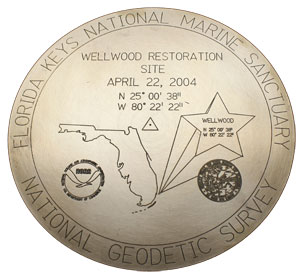Molasses Reef Sets UNDERWATER Geodetic Survey Marker
Near midnight on August 4th, 1984, the M/V Wellwood, a 400-foot steel-hulled freighter, struck Molasses Reef in the Florida Keys National Marine Sanctuary. This wasn’t good for the Wellwood, and it was disastrous for Molasses Reef; 1,280 square meters of coral reef habitat was  utterly destroyed, reduced to pulverized coral rubble.
utterly destroyed, reduced to pulverized coral rubble.
Court awarded restoration funds were paid out over 15 years, delaying restoration. During that period, the site was hit by two hurricanes that excavated 14 craters in the crushed reef framework. Restoration finally began in 2001 when exposed areas were filled in with precast “Reef Replacement Modules” made of quarried limestone and concrete. Made to mimic natural coral outcroppings with nooks, crannies and a “reef cave”, the structures represent the very latest thinking in coral reef restoration.
Because the modules are innovative, monitoring the recovery of the Wellwood Restoration Site is vital. Lessons learned will benefit reef restoration projects worldwide.
Berntsen International is proud to be part of this recovery effort. On June 17th, 2004, in an event sponsored by NOAA/NOS, the Marine Sanctuaries Program and the National Geodetic Survey, a 10-inch diameter brass monument, manufactured by Berntsen, was placed at precise coordinates and permanently embedded in the reef. It is believed to be the first high precision geodetic marker placed underwater anywhere in the world.
The marker is surrounded by a stainless steel frame to protect it and to provide attachment points for a meter tape and a portable fiberglass compass rose. Marine scientists can use these to accurately locate and measure features of interest in the recovery.
When not being used as a monitoring tool, a spar buoy will be anchored to the frame by means of a tautline mooring system. Since the highly visible buoy will be directly above the monument, boaters can use it to recalibrate GPS units, allowing more careful navigation in this highly sensitive area. The buoy will also mark the Wellwood restoration area for divers and snorkelers, allowing exploration of this interesting and beautiful project. Natural reef processes are already beginning to cover the replacement modules with mollusks, crustaceans, and countless other reef organisms. With the new monument in place, the reef can be monitored even as it gradually transforms and the rate of recovery can be measured. Eventually, the repaired area should blend in perfectly with the surrounding reef, and only the brass monument will mark the site of the M/V Wellwood damage.
Story by Greg Deangelo & Harold Hudson
Originally published in the Berntsen SurveyLog Volume 15, No. 3 (October, 2004)